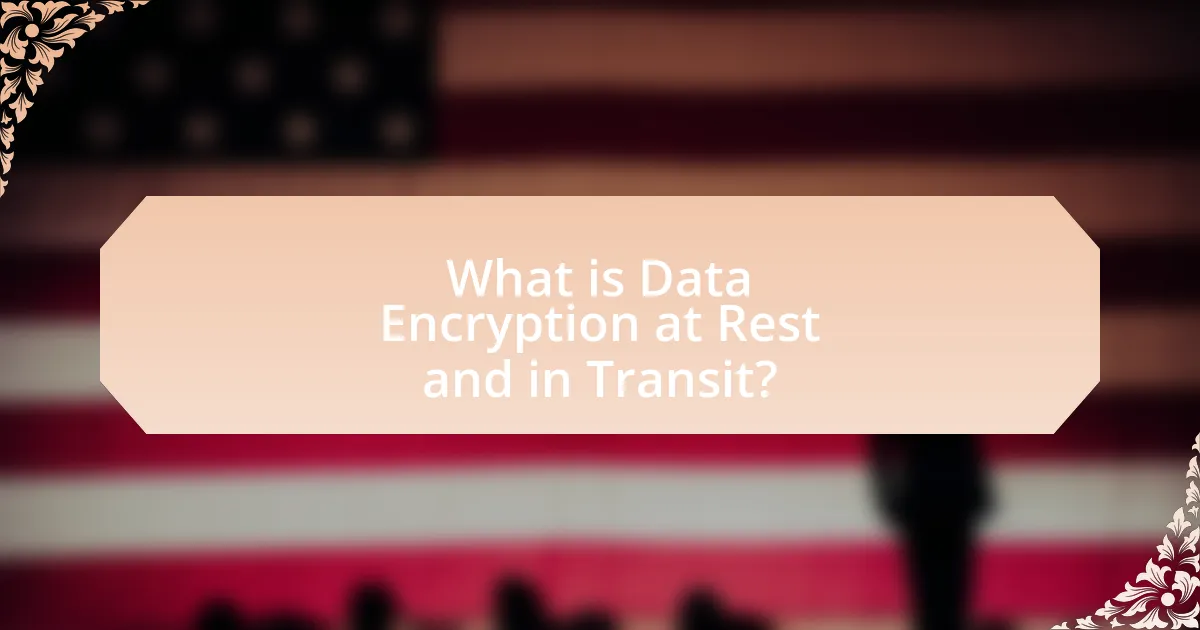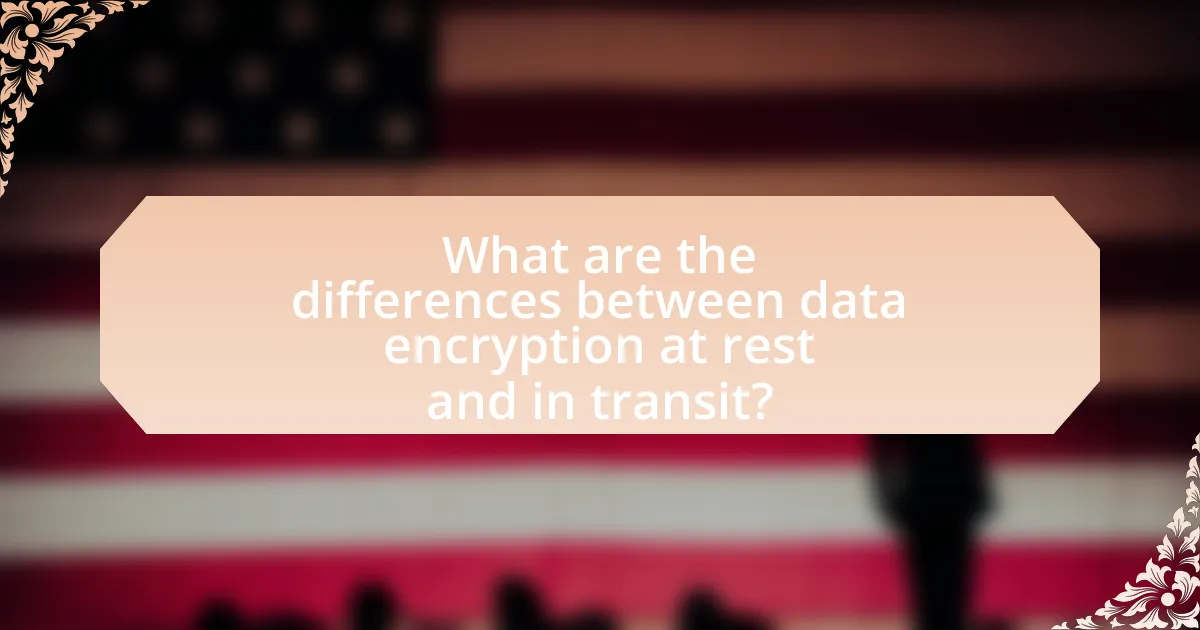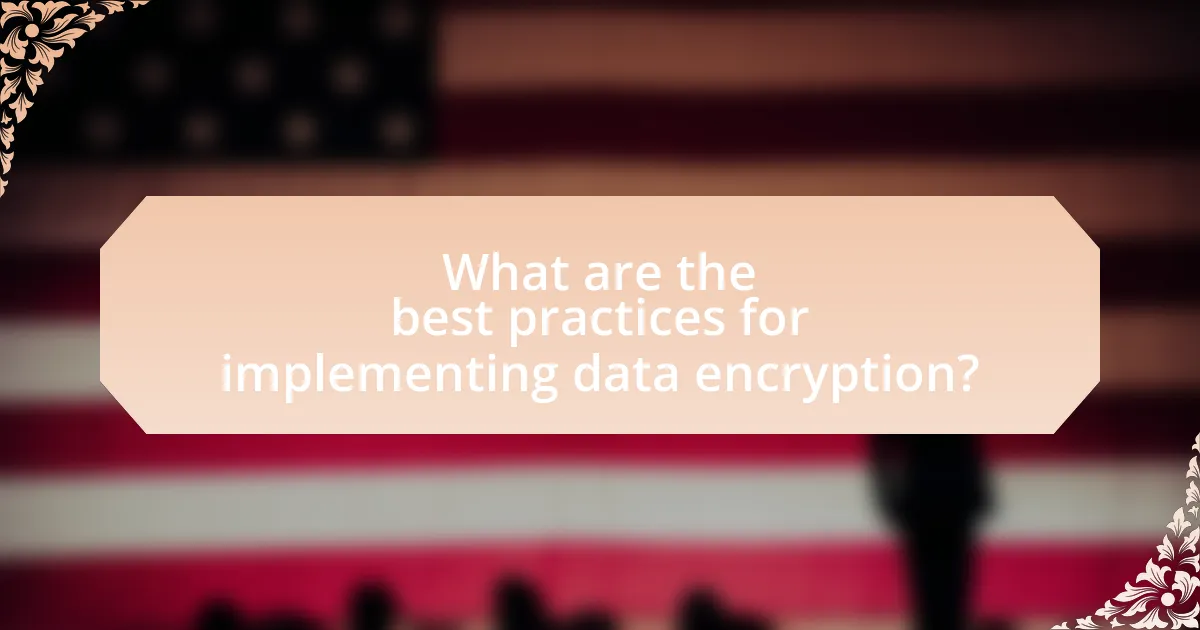Data encryption at rest and in transit is a critical security measure that protects sensitive information stored on devices and transmitted across networks. This article outlines the definitions, principles, and importance of data encryption, emphasizing its role in safeguarding personal and organizational data from unauthorized access and breaches. It discusses the mechanisms of encryption algorithms, the differences between encryption at rest and in transit, and the best practices for implementation, including compliance with regulations like GDPR and HIPAA. Additionally, the article addresses the risks associated with unencrypted data and the challenges organizations face in managing encryption effectively.

What is Data Encryption at Rest and in Transit?
Data encryption at rest refers to the protection of data stored on a device or server, ensuring that unauthorized users cannot access it without the proper decryption keys. This is crucial for safeguarding sensitive information, such as personal data and financial records, from breaches or theft. Data encryption in transit, on the other hand, involves securing data as it travels across networks, preventing interception by malicious actors during transmission. Both methods utilize cryptographic algorithms to encode the data, making it unreadable to anyone who does not possess the necessary keys to decrypt it. The implementation of these encryption techniques is essential for compliance with regulations like GDPR and HIPAA, which mandate the protection of sensitive information.
How does data encryption protect sensitive information?
Data encryption protects sensitive information by converting it into a coded format that is unreadable without the appropriate decryption key. This process ensures that even if unauthorized individuals gain access to the encrypted data, they cannot interpret or utilize it. For instance, the Advanced Encryption Standard (AES) is widely used and recognized for its effectiveness in securing data, as it employs complex algorithms that make unauthorized access exceedingly difficult. According to the National Institute of Standards and Technology (NIST), encryption is a critical component of data security, as it mitigates risks associated with data breaches and unauthorized access, thereby safeguarding personal and organizational information.
What are the key principles of data encryption?
The key principles of data encryption include confidentiality, integrity, authentication, and non-repudiation. Confidentiality ensures that only authorized parties can access the data, achieved through algorithms that transform plaintext into ciphertext. Integrity guarantees that the data remains unchanged during transmission or storage, often verified using hash functions. Authentication verifies the identity of the parties involved in the communication, typically through digital signatures or certificates. Non-repudiation prevents an entity from denying the authenticity of their signature on a document or a message, ensuring accountability. These principles are foundational in protecting sensitive information from unauthorized access and ensuring secure communication.
How do encryption algorithms work?
Encryption algorithms work by transforming plaintext data into ciphertext using mathematical functions and keys. These algorithms utilize a specific key to perform operations such as substitution and permutation, ensuring that only authorized users with the correct key can decrypt the data back into its original form. For example, the Advanced Encryption Standard (AES) employs a symmetric key algorithm, meaning the same key is used for both encryption and decryption, which is widely recognized for its security and efficiency. The effectiveness of encryption algorithms is validated by their ability to protect sensitive information from unauthorized access, as evidenced by their use in securing online transactions and communications.
Why is data encryption essential for modern businesses?
Data encryption is essential for modern businesses because it protects sensitive information from unauthorized access and data breaches. In an era where cyberattacks are increasingly common, encryption serves as a critical defense mechanism, ensuring that data remains confidential both at rest and in transit. According to a report by Cybersecurity Ventures, cybercrime is projected to cost the world $10.5 trillion annually by 2025, highlighting the urgent need for robust security measures like encryption. Furthermore, regulations such as the General Data Protection Regulation (GDPR) mandate the protection of personal data, making encryption not just a best practice but a legal requirement for compliance.
What risks are associated with unencrypted data?
Unencrypted data poses significant risks, primarily including unauthorized access, data breaches, and loss of confidentiality. Unauthorized access occurs when malicious actors exploit vulnerabilities to gain access to sensitive information, which can lead to identity theft or financial fraud. Data breaches are prevalent, with reports indicating that 80% of breaches involve unencrypted data, highlighting the critical need for encryption to protect sensitive information. Additionally, loss of confidentiality can result in reputational damage for organizations, as sensitive data exposure undermines trust with customers and stakeholders. These risks underscore the necessity of implementing robust encryption measures for data at rest and in transit.
How does data encryption enhance compliance with regulations?
Data encryption enhances compliance with regulations by protecting sensitive information from unauthorized access and breaches. Regulations such as the General Data Protection Regulation (GDPR) and the Health Insurance Portability and Accountability Act (HIPAA) mandate the safeguarding of personal and health-related data. By implementing encryption, organizations ensure that even if data is intercepted or accessed unlawfully, it remains unreadable without the decryption key. This not only mitigates the risk of data breaches but also demonstrates a commitment to data protection, which is a key requirement of many compliance frameworks. For instance, a study by the Ponemon Institute found that organizations using encryption experienced 50% fewer data breaches, thereby reinforcing their compliance posture.

What are the differences between data encryption at rest and in transit?
Data encryption at rest protects stored data, while encryption in transit secures data being transmitted over networks. Encryption at rest typically involves encrypting databases, file systems, or storage devices to prevent unauthorized access when data is not actively being used. In contrast, encryption in transit uses protocols like TLS (Transport Layer Security) to safeguard data as it moves between systems, ensuring confidentiality and integrity during transmission. The distinction is crucial for comprehensive data security strategies, as both methods address different vulnerabilities in data handling.
How does data encryption at rest function?
Data encryption at rest functions by converting stored data into a coded format that can only be accessed or decrypted by authorized users with the correct encryption keys. This process typically involves algorithms such as AES (Advanced Encryption Standard), which encrypts data before it is written to storage devices, ensuring that even if unauthorized individuals gain access to the physical storage, they cannot read the data without the decryption key. According to the National Institute of Standards and Technology (NIST), encryption at rest is crucial for protecting sensitive information from data breaches and unauthorized access, thereby maintaining data confidentiality and integrity.
What types of data are typically encrypted at rest?
Data typically encrypted at rest includes sensitive information such as personal identification data, financial records, healthcare information, and intellectual property. This encryption protects data stored on devices, databases, and cloud services from unauthorized access. For instance, the Health Insurance Portability and Accountability Act (HIPAA) mandates the encryption of healthcare data to ensure patient privacy. Similarly, the Payment Card Industry Data Security Standard (PCI DSS) requires encryption for credit card information to prevent fraud. These regulations highlight the critical need for encrypting sensitive data at rest to safeguard against data breaches and comply with legal standards.
What technologies are used for encrypting data at rest?
Technologies used for encrypting data at rest include Advanced Encryption Standard (AES), RSA encryption, and Transparent Data Encryption (TDE). AES is widely recognized for its efficiency and security, utilizing key sizes of 128, 192, or 256 bits, making it a standard in various applications. RSA encryption, based on the mathematical properties of prime numbers, is often used for secure key exchange and digital signatures. TDE, implemented in database management systems like Microsoft SQL Server and Oracle, encrypts the entire database file, ensuring that data is protected even when the database is inactive. These technologies are essential for safeguarding sensitive information stored on devices and servers.
How does data encryption in transit work?
Data encryption in transit works by converting data into a coded format before it is transmitted over a network, ensuring that unauthorized parties cannot access or interpret the information. This process typically employs protocols such as Transport Layer Security (TLS) or Secure Sockets Layer (SSL), which establish a secure connection between the sender and receiver. During transmission, the data is encrypted using algorithms that scramble the information, making it unreadable without the appropriate decryption key. For instance, TLS uses asymmetric encryption for the initial handshake to exchange keys securely, followed by symmetric encryption for the actual data transfer, which is faster and more efficient. This method effectively protects sensitive information, such as credit card numbers or personal data, from interception by malicious actors during transmission.
What protocols are commonly used for encrypting data in transit?
Commonly used protocols for encrypting data in transit include Transport Layer Security (TLS), Secure Sockets Layer (SSL), and Internet Protocol Security (IPsec). TLS is the most widely adopted protocol, providing encryption for web traffic and ensuring secure communication between clients and servers. SSL, although largely deprecated in favor of TLS, historically served a similar purpose. IPsec is utilized for securing Internet Protocol communications by authenticating and encrypting each IP packet in a communication session. These protocols are essential for protecting sensitive information from eavesdropping and tampering during transmission over networks.
How does encryption in transit protect data during transmission?
Encryption in transit protects data during transmission by converting the information into a secure format that is unreadable to unauthorized users. This process utilizes cryptographic protocols, such as TLS (Transport Layer Security), which establish a secure channel between the sender and receiver. By encrypting the data, even if it is intercepted during transmission, the content remains confidential and cannot be deciphered without the appropriate decryption key. This method significantly reduces the risk of data breaches and unauthorized access, as evidenced by the fact that encrypted communications are a standard practice in securing sensitive information online, such as financial transactions and personal data exchanges.

What are the best practices for implementing data encryption?
The best practices for implementing data encryption include using strong encryption algorithms, managing encryption keys securely, and ensuring compliance with relevant regulations. Strong encryption algorithms, such as AES-256, provide robust protection against unauthorized access. Secure key management involves generating, storing, and rotating keys in a manner that minimizes exposure to potential threats. Compliance with regulations like GDPR and HIPAA ensures that encryption practices meet legal standards for data protection. These practices collectively enhance the security of sensitive data both at rest and in transit.
How can organizations effectively implement data encryption?
Organizations can effectively implement data encryption by adopting a comprehensive strategy that includes selecting appropriate encryption algorithms, establishing key management protocols, and ensuring compliance with relevant regulations. For instance, using strong encryption standards such as AES-256 for data at rest and TLS for data in transit enhances security. Additionally, organizations should implement a robust key management system to securely generate, store, and rotate encryption keys, minimizing the risk of unauthorized access. Compliance with regulations like GDPR and HIPAA further reinforces the importance of encryption, as these frameworks mandate the protection of sensitive data. By integrating these practices, organizations can significantly mitigate the risks associated with data breaches and unauthorized access.
What factors should be considered when choosing encryption methods?
When choosing encryption methods, key factors include the level of security required, performance impact, regulatory compliance, and ease of implementation. The level of security is crucial as it determines how resistant the encryption is to attacks; for instance, AES-256 is widely recognized for its strong security. Performance impact is significant because some encryption algorithms can slow down system operations, which is critical for real-time applications. Regulatory compliance is essential to ensure that the chosen method meets legal standards, such as GDPR or HIPAA, which mandate specific encryption practices. Lastly, ease of implementation affects how quickly and effectively an organization can deploy the encryption solution, with some methods requiring more complex integration than others.
How can organizations ensure proper key management?
Organizations can ensure proper key management by implementing a comprehensive key management policy that includes key generation, storage, rotation, and destruction. This policy should adhere to industry standards such as NIST SP 800-57, which provides guidelines for key management practices. Additionally, organizations should utilize hardware security modules (HSMs) for secure key storage and employ encryption algorithms that meet current security requirements. Regular audits and compliance checks can further validate the effectiveness of the key management practices, ensuring that keys are managed securely throughout their lifecycle.
What common challenges do organizations face with data encryption?
Organizations commonly face challenges with data encryption, including key management, performance impacts, compliance issues, and user training. Key management is critical, as improper handling can lead to data loss or unauthorized access; a study by the Ponemon Institute found that 60% of organizations struggle with managing encryption keys effectively. Performance impacts arise when encryption processes slow down system operations, particularly in high-volume environments, which can hinder productivity. Compliance issues are prevalent, as organizations must adhere to various regulations like GDPR and HIPAA, which require specific encryption standards; failure to comply can result in significant fines. Lastly, user training is essential, as employees must understand encryption protocols to avoid mishandling sensitive data, yet many organizations report inadequate training programs.
How can organizations address performance issues related to encryption?
Organizations can address performance issues related to encryption by implementing hardware acceleration, optimizing encryption algorithms, and utilizing efficient key management practices. Hardware acceleration, such as using dedicated encryption chips or GPUs, significantly speeds up encryption and decryption processes, reducing latency. For instance, studies show that hardware-based encryption can improve performance by up to 10 times compared to software-based solutions. Additionally, selecting optimized algorithms, like AES-GCM, can enhance performance while maintaining security. Efficient key management, including the use of key rotation and centralized key storage, minimizes overhead and ensures that encryption processes do not bottleneck system performance.
What are the implications of lost or compromised encryption keys?
Lost or compromised encryption keys can lead to unauthorized access to sensitive data, resulting in data breaches and potential financial losses. When encryption keys are lost, the encrypted data becomes irretrievable, which can disrupt business operations and lead to compliance issues, especially in regulated industries. Additionally, compromised keys allow attackers to decrypt and manipulate data, undermining data integrity and confidentiality. According to a 2020 report by IBM, the average cost of a data breach is $3.86 million, highlighting the financial implications of such security failures. Furthermore, organizations may face reputational damage and loss of customer trust, as clients expect robust security measures to protect their information.
What practical steps can organizations take to enhance data encryption?
Organizations can enhance data encryption by implementing strong encryption algorithms, such as AES-256, for both data at rest and in transit. This ensures that sensitive information is protected against unauthorized access. Additionally, organizations should regularly update their encryption protocols to address vulnerabilities, as evidenced by the fact that outdated encryption methods can be easily compromised.
Furthermore, employing key management best practices, including the use of hardware security modules (HSMs) for key storage, significantly reduces the risk of key exposure. Regularly conducting security audits and penetration testing can also identify weaknesses in encryption implementations, allowing organizations to strengthen their defenses.
Training employees on the importance of encryption and secure data handling practices is crucial, as human error often leads to data breaches. By following these steps, organizations can significantly enhance their data encryption efforts and protect sensitive information effectively.